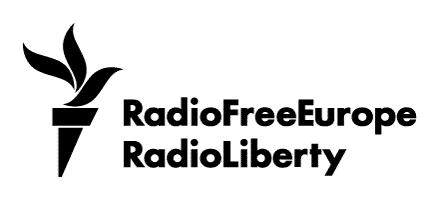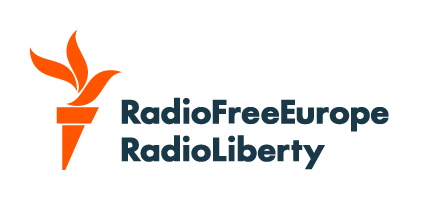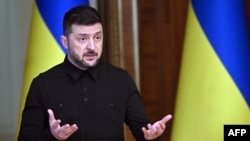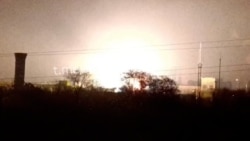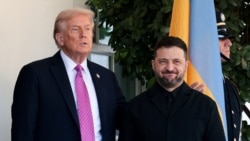The European Union and Ukrainian President Volodymyr Zelenskyy expressed doubts about Russian President Vladimir Putin's willingness to end the more than three-year war in Ukraine as the prospect of a summit in Budapest with US President Donald Trump looms.
Zelenskyy said that he's "ready" to sit down for peace talks in the Hungarian capital, a venue criticized by the European Union given there's an International Criminal Court arrest warrant outstanding against Putin.
European Union foreign policy chief Kaja Kallas said on October 20 that, while Trump's peace efforts are welcome, "we don't see Russia really wanting peace."
"Russia only understands strength and only negotiates when it's really put to negotiate. So, right now, we don't see it yet," she said.
"Regarding Budapest, no, it's not nice...to see that really a person put to the arrest warrant by the ICC is coming to a European country," Kallas said, adding that the "question is whether there is any outcome."
Zelenskyy also said Budapest is not the best meeting place for peace talks and doubted that Hungarian Prime Minister Viktor Orban, who he said "is blocking Ukraine everywhere," can do something positive for Ukrainians.
"It seems to me that among the people who constantly promote the idea of Russia's supposedly unconditional advantages in this war, there is also the current prime minister of Hungary. And when we talk about mediation, I do not believe that the current prime minister of Hungary has an adequate attitude to this," Zelenskyy told reporters on October 19, according to Interfax.
The Ukrainian president said on October 20 that he believes Putin prefers to postpone "real peace negotiations" and is reluctant to meet with him because that would require agreeing to specific positions and potential concessions to end the war.
Zelenskyy then called for added pressure on the Russian leader, saying that Putin is "afraid of sanctions" and secondary sanctions that would squeeze the Russian economy.
Ukrainian Foreign Minister Andriy Sybiha added in a post on X on October 20 that "Putin has no intention of ending this war -- he only tries to buy time. That’s why we need pressure, pressure, and pressure. The only thing Putin understands."
The Kremlin in turn accused Ukraine of sending contradictory signals that are making it more difficult to find a path toward peace as Moscow tries to engage in serious work with Washington.
"Full-scale preparations for the summit have yet to begin," Kremlin spokesman Dmitry Peskov told reporters in Moscow on October 20.
"Of course, everyone is fulfilling the orders given by the presidents, but
large-scale consultations, teamwork on the proper conditions for the
summit have not begun. It will begin shortly," he added.
The comments come after Trump welcomed Zelenskyy to Washington on October 17 to discuss future peace negotiations.
Zelenskyy arrived prepared to discuss a potential arms deal in which Ukraine would supply the US military with drone technologies in return for long-range Tomahawk missiles, but Trump appeared to have cooled on the idea of providing Ukraine with the weapons.
Instead, the US president urged Russia and Ukraine to immediately cease fighting, saying enough blood had been shed, and announced that he plans to meet Putin in Budapest in the coming weeks. No date has been set for the summit.
During an interview with NBC, Zelenskyy reiterated his openness to engage in bilateral or trilateral peace talks with the United States and Russia at the table.
He also said that fighting on the battlefield should stop along the current contact line between Russian and Ukrainian forces and a cease-fire should be in place to begin peace talks.
"If we want to stop this war and go to peace negotiations," Zelenskyy said, "we need to stay where we stay and not give something additional to Putin because he wants it."
What Comes Next As Negotiators Eye A Summit In Budapest?
The Washington Post reported on October 18 that Putin demanded that Kyiv surrender full control of the Donetsk region, a strategically vital area of eastern Ukraine that is partially occupied by Moscow, as a condition for ending the war during an October 16 phone call with Trump.
In comments late on October 19, Trump said the region should "be cut the way it is now," with Russia controlling about 78 percent of Donetsk territory.
Citing people familiar with the matter, the Financial Times reported on October 19 that Trump told Zelenskyy during their White House meeting to accept Russia's terms for ending the war, including ceding the Donetsk region.
However, in remarks to reporters on October 19, Trump denied that he had discussed Ukraine ceding Donetsk to Russia.
According to the FT report, Trump warned Zelenskyy that Putin had threatened to "destroy" Ukraine if it didn't agree to his terms.
Asked in a Fox News interview whether Putin was likely to accept a peace deal without taking vast amount of Ukrainian territory, Trump said: “Well, he's gonna take something."
Territorial concessions are expected to be part of any eventual peace deal for Ukraine, but it’s uncertain what Putin might agree to -- or what Kyiv could legally offer.
Ukraine’s constitution mandates a nationwide referendum to approve any change to the country’s territory, a vote that cannot be held under the martial law imposed since Russia’s full-scale invasion in 2022.
A key reason for Zelenskyy's trip to Washington was the possibility of Ukraine receiving Tomahawk missiles, which are capable of hitting targets at a distance of up to 2,500 kilometers.
Trump appeared to have considered sending Tomahawks to Kyiv for weeks as he grew increasingly frustrated over Putin's refusal to negotiate an end to the war but then appeared to rule out the possibility -- at least for now -- after his call with the Russian president.
Zelenskyy claimed that issue of Tomahawk missiles is "very sensitive for the Russians" and that Putin is "afraid that the United States will deliver [them] to Ukraine" because it would allow Kyiv to strike strategic military sites and infrastructure that could derail Russia's war effort.
Zelenskyy said in his evening video message on October 20 that is is working with the United States on the purchase of Patriot air defense systems.
"In Washington, I spoke with defense companies that produce Patriots and other weapons we need," Zelenskyy said. "The willingness to work with Ukraine is fully sufficient -- Ukraine is trusted. It is important that there be enough support for this at the political level in Washington."


